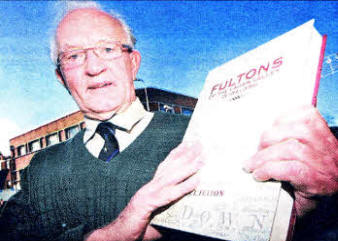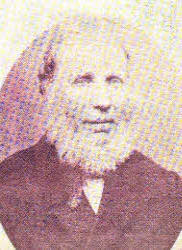
Rip roaring stories of a Lisburn family gathered in new book
 WHEN Trevor Fulton was a young child he was fascinated by
the portraits of a man and woman hanging on the wall of his grandfather's
house near Lisburn.
WHEN Trevor Fulton was a young child he was fascinated by
the portraits of a man and woman hanging on the wall of his grandfather's
house near Lisburn.
Over the years he learned they were his great grandfather William Fulton, who was born in Killultagh House outside Lisburn, and his wife Susan Doherty.
William's rip roaring life - he crossed America on horseback to California where he had been a gold miner before sailing around South America -was the stuff of boys' own adventure.
Now Trevor's life-long curiosity with the family has led the 75-year-old to publish the results of years of family history research in a new book, Fultons of the Lagan Valley in Ireland.
A retired engineer who now lives in Poole in Dorset, he was aware that Sir Theodore Hope, also a descendant of the Fultons, had written a book 'Fultons of Lisburn' in 1906. But when he realised his branch of the family were not mentioned, he decided to update it.
 It led to him scouring the Public Records Office, church
records, libraries, Linenhall Library in Belfast, the Indian and oriental
collection of the British Library and even the Library of Congress in
Washington to research his book. He also went to America where he discovered
old Californian gold mines where his great grandfather worked. Trevor
explained: "It was really an attempt to rescue as much lost information as
possible and get it down on paper before it would disappear completely.
It led to him scouring the Public Records Office, church
records, libraries, Linenhall Library in Belfast, the Indian and oriental
collection of the British Library and even the Library of Congress in
Washington to research his book. He also went to America where he discovered
old Californian gold mines where his great grandfather worked. Trevor
explained: "It was really an attempt to rescue as much lost information as
possible and get it down on paper before it would disappear completely.
"It has been utterly fascinating and I have found out things I would never have imagined. Like all family histories this will probably not be the last word on the subject. It was built on earlier work and presents the story based on the information available currently, but will I am sure be subject to amendment and addition in the future as more information about the past is found and more generations are added."
 Trevor learned that after his great grandfather had
returned from America, apparently intending a holiday visit before returning
to California. But while here he met and married Susan, a teacher from
Donegal, before settling down at Rose Cottage, a small farm near Upper
Ballinderry crossroads. The Fulton name originated from Ayrshire in Scotland
from where many emigrated to Ireland. Most people moving to Lisburn were
from England and Wales but the first records of Fultons were in 1653 when a
Richard Fulton moved to Conway's estate in Lagan Valley.
Trevor learned that after his great grandfather had
returned from America, apparently intending a holiday visit before returning
to California. But while here he met and married Susan, a teacher from
Donegal, before settling down at Rose Cottage, a small farm near Upper
Ballinderry crossroads. The Fulton name originated from Ayrshire in Scotland
from where many emigrated to Ireland. Most people moving to Lisburn were
from England and Wales but the first records of Fultons were in 1653 when a
Richard Fulton moved to Conway's estate in Lagan Valley.
The next generation of the family, Richard Fulton, moved about 1720 from Belsize Farm into Lisburn where he and his children had properties in Bow Street and Market Street where they owned, among other things, a tannery and a public house, the Bear Inn. James was appointed by First Lisburn Presbyterian Church to oversee its construction. His initials can still be seen on the window ledge today.
A descendant, John Fulton, travelled in India to make his fortune and in 1780s. He died as he attempted to return to Lisburn in 1803. His son John jnr became Mayor of Calcutta and had an estimated fortune of £5m.
 Trevor was a civil engineer who has lived in Nigeria,
Gibraltar and Germany, also discovered that descendants of the Fultons went
to California and New Zealand. Many found careers in business, the military,
the law and civil engineering and surveying. Some had administrative posts
in the Empire in India and New Zealand. There were at least five
knighthoods, elected members of parliaments in London, New Zealand and the
Australian State of Victoria, and three reached field rank in the armies of
Britain or India. Several lost their lives in the Afghan Wars of the 19th
century, the Indian Mutiny at Gallipoli and the Western Front in the First
World War and in Burma in the Second World War.
Trevor was a civil engineer who has lived in Nigeria,
Gibraltar and Germany, also discovered that descendants of the Fultons went
to California and New Zealand. Many found careers in business, the military,
the law and civil engineering and surveying. Some had administrative posts
in the Empire in India and New Zealand. There were at least five
knighthoods, elected members of parliaments in London, New Zealand and the
Australian State of Victoria, and three reached field rank in the armies of
Britain or India. Several lost their lives in the Afghan Wars of the 19th
century, the Indian Mutiny at Gallipoli and the Western Front in the First
World War and in Burma in the Second World War.
He also discovered other descendants including Douglas Hyde the founder of the Gaelic League and the first president of the Irish Free State and Frank Worsley, the master of Sir Edward Shackleton's ship Endurance on the Antarctic expedition who accompanied him as a navigator in the open boat journey to Elephant Island.
Fultons of the Lagan Valley in Ireland can be purchased at the Linen Centre or Waterstones for £15.
Ulster Star
12/11/2009
